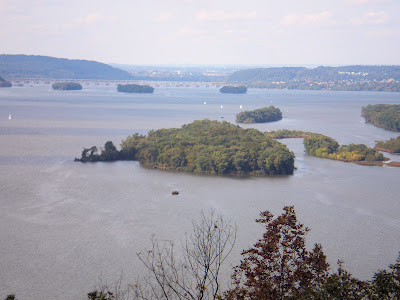 Today I had the great good fortune to meet Brenda Smith in person. I've known Brenda online for some time, admire her work, and read her blog regularly. I also follow the 12 x 12 collaborative art project that Brenda is part of, along with Gerrie and Terry, who I met in Oregon earlier this year. When I learned that Brenda was in the country and coming to Lancaster, I rearranged my schedule so I could meet her, and her equally charming travelling companions, for lunch today at the Iron Hill Brewery. We raised a glass and had a chance to chat about art and life and connections, and a good time was had by all. I love the way the blogosphere and Facebook facilitate these types of encounters. Thanks, Brenda, and best wishes for the remainder of your travels.
Today I had the great good fortune to meet Brenda Smith in person. I've known Brenda online for some time, admire her work, and read her blog regularly. I also follow the 12 x 12 collaborative art project that Brenda is part of, along with Gerrie and Terry, who I met in Oregon earlier this year. When I learned that Brenda was in the country and coming to Lancaster, I rearranged my schedule so I could meet her, and her equally charming travelling companions, for lunch today at the Iron Hill Brewery. We raised a glass and had a chance to chat about art and life and connections, and a good time was had by all. I love the way the blogosphere and Facebook facilitate these types of encounters. Thanks, Brenda, and best wishes for the remainder of your travels.
December 29, 2009
Meeting Brenda Smith
 Today I had the great good fortune to meet Brenda Smith in person. I've known Brenda online for some time, admire her work, and read her blog regularly. I also follow the 12 x 12 collaborative art project that Brenda is part of, along with Gerrie and Terry, who I met in Oregon earlier this year. When I learned that Brenda was in the country and coming to Lancaster, I rearranged my schedule so I could meet her, and her equally charming travelling companions, for lunch today at the Iron Hill Brewery. We raised a glass and had a chance to chat about art and life and connections, and a good time was had by all. I love the way the blogosphere and Facebook facilitate these types of encounters. Thanks, Brenda, and best wishes for the remainder of your travels.
Today I had the great good fortune to meet Brenda Smith in person. I've known Brenda online for some time, admire her work, and read her blog regularly. I also follow the 12 x 12 collaborative art project that Brenda is part of, along with Gerrie and Terry, who I met in Oregon earlier this year. When I learned that Brenda was in the country and coming to Lancaster, I rearranged my schedule so I could meet her, and her equally charming travelling companions, for lunch today at the Iron Hill Brewery. We raised a glass and had a chance to chat about art and life and connections, and a good time was had by all. I love the way the blogosphere and Facebook facilitate these types of encounters. Thanks, Brenda, and best wishes for the remainder of your travels.
December 21, 2009
Watt & Shand #10 Underway
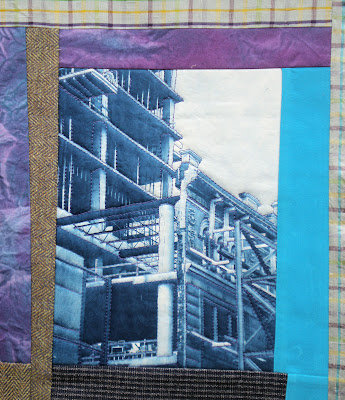 Watt & Shand #10 is underway. It features images from May of 2008, when the facade of the original building was still supported by an elaborate scaffolding, and the framework of the Marriott was rising up behind. I was interested in one of the intersections of the old construction and the new, a corner that jutted out on King Street and gave a glimpse into the interior.
Watt & Shand #10 is underway. It features images from May of 2008, when the facade of the original building was still supported by an elaborate scaffolding, and the framework of the Marriott was rising up behind. I was interested in one of the intersections of the old construction and the new, a corner that jutted out on King Street and gave a glimpse into the interior. This one features cyanotypes and digital prints, and the color scheme is rather bold, in a good and exciting way that really sets off the prints. Right now it looks a bit stark, but the quilting will calm and unify it.
This one features cyanotypes and digital prints, and the color scheme is rather bold, in a good and exciting way that really sets off the prints. Right now it looks a bit stark, but the quilting will calm and unify it.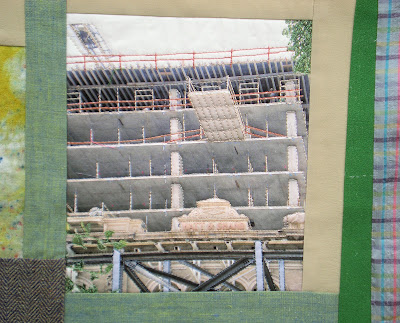 It's time to take a break from creating tops--as addictive and engaging as that is-- and focus on quilting and finishing the ones I have stacked up and waiting. I am well on track towards having the series done in time for the exhibition at the Arts Hotel Gallery in March 2010.
It's time to take a break from creating tops--as addictive and engaging as that is-- and focus on quilting and finishing the ones I have stacked up and waiting. I am well on track towards having the series done in time for the exhibition at the Arts Hotel Gallery in March 2010.If you are new here, you can track back this project by clicking on Watt & Shand under Labels in the right sidebar.
And a Happy Solstice to one and all! More daylight will be a very good thing.
December 10, 2009
Number Nine, Number Nine, Number Nine....
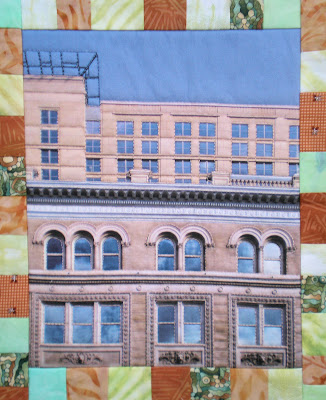 I've finished the design and put together the top for Watt & Shand #9. It uses images from photos I took in February of this year. It's unique in the series so far because the pictures are from the South Queen Street side of the project, around the corner from King Street where the rest were taken. Above you see the original Watt & Shand building facade, with the new Marriott Hotel rising up behind it. (If you are new here, you can track back the series and the project by clicking on Watt & Shand under Labels in the right sidebar.)
I've finished the design and put together the top for Watt & Shand #9. It uses images from photos I took in February of this year. It's unique in the series so far because the pictures are from the South Queen Street side of the project, around the corner from King Street where the rest were taken. Above you see the original Watt & Shand building facade, with the new Marriott Hotel rising up behind it. (If you are new here, you can track back the series and the project by clicking on Watt & Shand under Labels in the right sidebar.)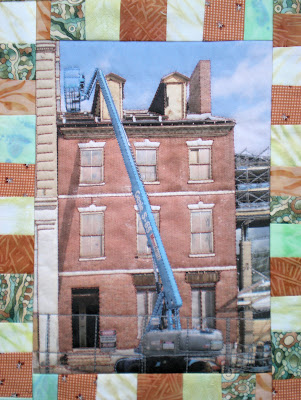 In between the old Watt & Shand building and the new convention center on Vine Street is the
In between the old Watt & Shand building and the new convention center on Vine Street is theWilliam Montgomery House, seen above, a historic Federalist building that was restored and incorporated into the project--it's a prominent and very cool feature inside the lobby of the new hotel. The interior of the house awaits further renovation as funds permit.
I've got #10 up on the design wall right now, and am contemplating what comes next. I'm winding down this series of works, at least in terms of design--I have lot of intensive quilting ahead of me to get all the pieces finished and ready for the exhibit in March. There's one rebellious corner of my mind where I'm chomping at the bit to do a botanical piece, with lots of bright colors and swooping organic shapes, but for now I'm really enjoying exploring the grids and architectural lines, and celebrating the beauty of this glorious Beaux Arts building.
November 24, 2009
Watt & Shand #8 Underway
 I've put together another top in Watt & Shand series. It features images from February of this year, when the construction was starting to wind to a close. A worker was on the roof of the original building, installing the replacement balustrades when I took these pictures.
I've put together another top in Watt & Shand series. It features images from February of this year, when the construction was starting to wind to a close. A worker was on the roof of the original building, installing the replacement balustrades when I took these pictures. My focus for the design of #8 was on repetition and scale, and I kept the color scheme somewhat muted, at least by my standards, so as to key in on these elements.
My focus for the design of #8 was on repetition and scale, and I kept the color scheme somewhat muted, at least by my standards, so as to key in on these elements. One thing I am enjoying about working so intently on this series is the familiarity I am gaining with the details of the building. I've spent years taking the photos, a lot of time choosing, editing and tweaking the ones for each quilt, and then more time putting the prints onto fabric in various ways. This is all followed by a lot of intensive stitching, tracing the outlines of the windows, the stonework, the Beaux Art ornamentation, and construction structures like scaffolding and cranes. It's all been time well spent, for at this point I feel like I know my subject matter, in terms of line and form, very intimately. It's opened me up to new lines of thought and expression because I am so confident of the fundamentals.
If you are new here, you can follow this project back to its inception by clicking on "Watt & Shand" under Labels in the right sidebar. And if you have been following along for some time, thank you very much, I so appreciate everyone who checks in and comments.
November 18, 2009
Watt & Shand #7 in Progress
 How great is this image? I got lucky the day I captured this moment in the construction process. It's one of the images from March of this year I am using in Watt & Shand #7.
How great is this image? I got lucky the day I captured this moment in the construction process. It's one of the images from March of this year I am using in Watt & Shand #7.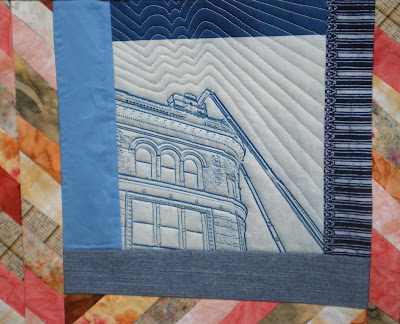 #7 also has this cyanotype image, a bit of a departure from the way I usually print them that is pleasing me very much. The whole piece has a very dynamic and energetic feel to it so far.
#7 also has this cyanotype image, a bit of a departure from the way I usually print them that is pleasing me very much. The whole piece has a very dynamic and energetic feel to it so far.If you are new here, you can follow the evolution of this series, where I chronicle the conversion of a historic Beaux Arts building in Lancaster, PA into a hotel and convention center, by clicking on "Watt & Shand" under Labels in the right sidebar and tracking it back.
And just a reminder that my solo show, "Nature Quilts" continues for the rest of the month at Isadore Gallery--check the website for details and stop in if you are in the area. Thanks!
November 11, 2009
Isadore Gallery Opening Reception
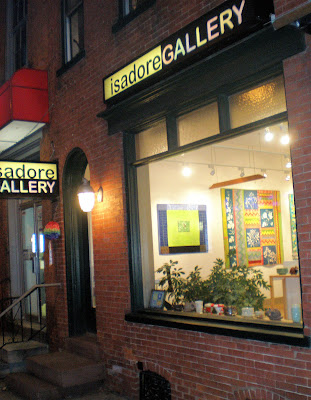 Pictures from an exhibition--here's the street view of Isadore Gallery on Friday at the start of the opening reception:
Pictures from an exhibition--here's the street view of Isadore Gallery on Friday at the start of the opening reception: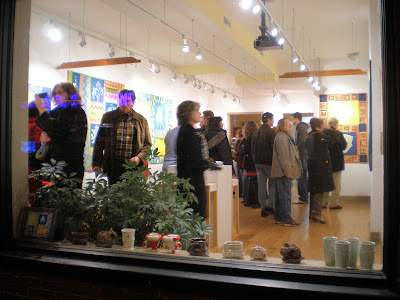 The gallery was packed almost non-stop for the entire evening. I had the distinct pleasure of talking with many of the visitors about my work, art, and life in general.
The gallery was packed almost non-stop for the entire evening. I had the distinct pleasure of talking with many of the visitors about my work, art, and life in general. I am greatly indebted to the owners and staff at the gallery for the care and skill with which they hung and lit the work. The exhibit flowed very nicely around the gallery space.
I am greatly indebted to the owners and staff at the gallery for the care and skill with which they hung and lit the work. The exhibit flowed very nicely around the gallery space. I am grateful for the work they put into publicizing it and bringing in the crowds--there were an estimated 500 people through the gallery over the course of the evening! I also benefited from the vibe of First Friday, which plays a critical role as Lancaster positions itself as an arts destination. Gallery Row was hopping all night long.
I am grateful for the work they put into publicizing it and bringing in the crowds--there were an estimated 500 people through the gallery over the course of the evening! I also benefited from the vibe of First Friday, which plays a critical role as Lancaster positions itself as an arts destination. Gallery Row was hopping all night long. The exhibit is up until the end of November, so stop in if you are in the area (check the website for hours.)
The exhibit is up until the end of November, so stop in if you are in the area (check the website for hours.)November 5, 2009
Today's Feature: Cold Cave
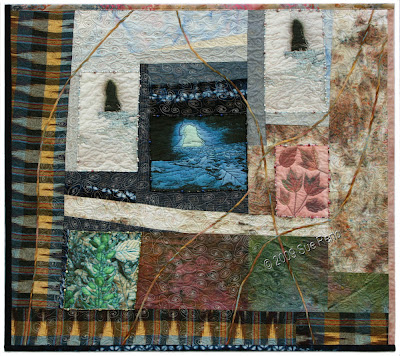 The final installment of Today's Feature spotlights "Cold Cave", a work based on numerous visits one of the largest tectonic caves in the eastern U.S. A cool wind blows up from the narrow cleft in the rock at the mouth of the cave even on the hottest summer day, and the brave and/or slightly foolhardy can venture in some distance and experience the utter and total darkness. Experienced cavers can explore the extensive labyrinth and despair at the graffiti left by the disrespectful. I went in once years ago, but today consider discretion the better part of valor, and now just content myself with a peak inside and the appreciation of the surrounding woodsy terrain.
The final installment of Today's Feature spotlights "Cold Cave", a work based on numerous visits one of the largest tectonic caves in the eastern U.S. A cool wind blows up from the narrow cleft in the rock at the mouth of the cave even on the hottest summer day, and the brave and/or slightly foolhardy can venture in some distance and experience the utter and total darkness. Experienced cavers can explore the extensive labyrinth and despair at the graffiti left by the disrespectful. I went in once years ago, but today consider discretion the better part of valor, and now just content myself with a peak inside and the appreciation of the surrounding woodsy terrain.*******************
The center (blue) image has been manipulated in a photo program, then printed on silk satin. The two pale images on the sides were printed on cotton, as were the two leaf panels. Other panels are from fabric I handpainted, and the fabulous bit of vintage damask on the upper right was sugar-dyed by my friend Deb Lacativa. The borders on the left and bottom are from a piece of ikat rayon I brought back from India in the 70's and have been hoarding for just the right moment, which finally came. It is embellished with couched yarns and handbeading with seed beads and larger glass beads . You can read more about it as a work-in-progress by clicking on "Cold Cave" under Labels in the right sidebar.
*********************
On the face of it, this work contains a lot of seemingly disparate elements, but I feel they all work well together and contribute to a whole that is larger than the sum of its parts, and that it successfully conveys the concept of a cold cave in the woods.
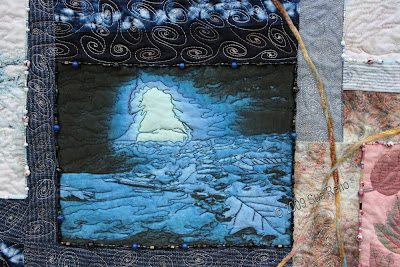 "Cold Cave" was selected to be exhibited as part of Images 2009 at the Robeson Gallery, Penn State University this past summer. Starting today, you can see it at the Isadore Gallery in Lancaster, PA.
"Cold Cave" was selected to be exhibited as part of Images 2009 at the Robeson Gallery, Penn State University this past summer. Starting today, you can see it at the Isadore Gallery in Lancaster, PA. ***********************
I hope you've enjoyed my in depth look over the past few weeks at the work for this exhibit, and I especially hope that if you are in the area you will stop in and say hello at the opening reception tomorrow, November 6th, from 5 - 9 p.m. And my thanks to everyone who has taken the time to read my posts and comment or email me--I greatly appreciate your encouragement and support!
November 4, 2009
Today's Feature: Royal Paulownia
 Today's Feature is "Royal Paulownia", another large-leafed wonder. If you've ever been out and about in the eastern or midwestern U.S. and found a really big leaf, it was probably a Royal Paulownia. The tree is not a native; it's an sometimes deliberate, sometimes accidental import from the orient. It self seeds rather enthusiastically, and often shows up along roadsides, recently cleared areas, and weedy gardens as a sapling that looks to be on steroids. The mature trees-and they are fast growers-sport cascades of purple flowers early in spring.
Today's Feature is "Royal Paulownia", another large-leafed wonder. If you've ever been out and about in the eastern or midwestern U.S. and found a really big leaf, it was probably a Royal Paulownia. The tree is not a native; it's an sometimes deliberate, sometimes accidental import from the orient. It self seeds rather enthusiastically, and often shows up along roadsides, recently cleared areas, and weedy gardens as a sapling that looks to be on steroids. The mature trees-and they are fast growers-sport cascades of purple flowers early in spring. *************************
The top image is a heliographic print, and the one on the bottom is a cyanotype. The borders are pieced from silks brought back from Mysore, India, combined with handwovern Indian cottons. It was very heavily and closely stitched, except for the leaves, where the stitching for the veining is more widely spaced. I rinsed, then blocked and dried the work after the stitching, causing the wrinkling and patterning on the leaf surfaces; I then used a dry brush technique to enhance those textures with paint. The final step in the construction was handbeading with seed beads and semi-precious stones.
 I am deeply honored that "Royal Paulownia" was selected to be a part of the exhibit "Connecting Colors and Cultures: First Kyrgyz-American Quilt Exhibit" which was held at the Museum of Fine Art in Bishkek, Kyrgyzstan. You can see it later this week in Lancaster, PA, at the Isadore Gallery.
I am deeply honored that "Royal Paulownia" was selected to be a part of the exhibit "Connecting Colors and Cultures: First Kyrgyz-American Quilt Exhibit" which was held at the Museum of Fine Art in Bishkek, Kyrgyzstan. You can see it later this week in Lancaster, PA, at the Isadore Gallery.November 3, 2009
Today's Feature: Sumac
 Today's Feature is "Sumac", named for the smooth sumac, or Rhus glabra (not to be confused with poison sumac). It's a very common wild plant here in Pennsylvania, and it puts on a magnificent display of fall color. There's a big patch of it in a wooded spot at the end of my street, and when the slanting fall sun hits it in the afternoon it's just spectacular.
Today's Feature is "Sumac", named for the smooth sumac, or Rhus glabra (not to be confused with poison sumac). It's a very common wild plant here in Pennsylvania, and it puts on a magnificent display of fall color. There's a big patch of it in a wooded spot at the end of my street, and when the slanting fall sun hits it in the afternoon it's just spectacular.***********************
The main panel is a heliographic print, done with textile paints on fabric and using the plant itself as a resist. I got very lucky with this one and captured the colors and leaf images just right on the first try. It hung on my design wall for months while I concocted and then discarded various schemes for enhancing it. I don't usually dither, so dropped the indecisiveness and jumped into a simple and elegant scheme of warm tones and rich textures. There's velveteen (which sucks up the light and doesn't photograph well), red and yellow silks, a bit of Seminole piecing, and just the right amount of embellishment with seed beads, larger glass beads, and semi-precious stones.
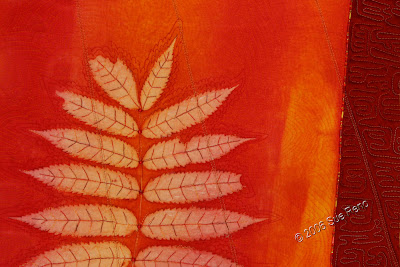 "Sumac" has done well for me on the show circuit; it was juried into Materials Hard and Soft, a fine craft exhibit in Denton, Texas, and it won an award at the International Quilt Festival in Houston, Texas. It will be one of the works in my solo show, opening in a few days, at the Isadore Gallery in Lancaster, PA.
"Sumac" has done well for me on the show circuit; it was juried into Materials Hard and Soft, a fine craft exhibit in Denton, Texas, and it won an award at the International Quilt Festival in Houston, Texas. It will be one of the works in my solo show, opening in a few days, at the Isadore Gallery in Lancaster, PA.
November 2, 2009
Today's Feature: Tall Blue Lettuce
 Today's feature of work that will be at the Isadore Gallery is "Tall Blue Lettuce", eponymously named for the plant, Lactura biennis, whose leaves form the prints. It is yet another example of easily seduced I am by an oversized leaf. I was stopped in my tracks while hiking one day by this six foot, rankly growing plant with foot long, hairy leaves and blue flowers, and hurried home to begin work on this interpretation.
Today's feature of work that will be at the Isadore Gallery is "Tall Blue Lettuce", eponymously named for the plant, Lactura biennis, whose leaves form the prints. It is yet another example of easily seduced I am by an oversized leaf. I was stopped in my tracks while hiking one day by this six foot, rankly growing plant with foot long, hairy leaves and blue flowers, and hurried home to begin work on this interpretation.********************************
The biennis in the name refers to its growth habit; as a biennal, it grows a rosette of leaves and a taproot in the first year, and in the second year it uses the reserves in the root to shoot up and produce blooms and seeds. It has a variety folkloric uses as a herbal remedy, not that I've tried any of them, and is very common over a wide range in North America. Once you've identified it, you spot it everywhere, especially in moister environs, and in your own backyard if you've been slack about the weeding (ahem).
 The print on the left is a cyanotype on cotton, the one of the right is a heliograph, and for both of them I added the veining with hand embroidery using variegated threads. The borders were pieced with Seminole work, and it's extensively machine stitched in a variety of patterns. It's a big, cheerful, in-your-face kind of piece, not unlike the plant, and has proven very popular on the show circuit, winning an award at The Pennsylvania National Quilt Extravaganza, serving as the cover quilt for an issue of The Professional Quilter Magazine, and as part of a feature article in Quilter's Newsletter Magazine.
The print on the left is a cyanotype on cotton, the one of the right is a heliograph, and for both of them I added the veining with hand embroidery using variegated threads. The borders were pieced with Seminole work, and it's extensively machine stitched in a variety of patterns. It's a big, cheerful, in-your-face kind of piece, not unlike the plant, and has proven very popular on the show circuit, winning an award at The Pennsylvania National Quilt Extravaganza, serving as the cover quilt for an issue of The Professional Quilter Magazine, and as part of a feature article in Quilter's Newsletter Magazine. November 1, 2009
Today's Features: The Fledgling and Tulip Poplar
 It's a two-fer today, the first of November, as I continue to highlight work that will be at my show at the Isadore Gallery, opening later this week. First up is "The Fledgling", my celebration of being in the right place at the right time with a camera handy. Every year we have robins nesting on a high beam underneath our deck, and it's entertaining to watch them grow. This bird had just fledged-left the nest-and made its first short flight to the adjacent locust tree. Once perched there, it was temporarily unable to go any further, and by sidling up slow and easy I was able to get some great photographs.
It's a two-fer today, the first of November, as I continue to highlight work that will be at my show at the Isadore Gallery, opening later this week. First up is "The Fledgling", my celebration of being in the right place at the right time with a camera handy. Every year we have robins nesting on a high beam underneath our deck, and it's entertaining to watch them grow. This bird had just fledged-left the nest-and made its first short flight to the adjacent locust tree. Once perched there, it was temporarily unable to go any further, and by sidling up slow and easy I was able to get some great photographs.***************************
I messed with this image digitally a bit, then printed it onto a tightly woven pima cotton. The green background is a heliographic print made with leaves from the same locust tree. Visually, it serves as the vast unknown that the fledgling is preparing to launch into. The other borders, evocative of earth and sky, represent its parameters in the natural world.

"The Fledgling" was shown widely in quilt shows, including the touring exhibit of Sacred Threads.
******************************
Next up in the spotlight is "Tulip Poplar". I love these trees, with their tall, upright structure, distinctive leaf shape, and especially the flowers, which do resemble tulips a bit. I once lived where I could look down on a tulip poplar from a second story window, an ideal vantage point for appreciating the flowers.
 The top two leaf images are leaf prints on silk, and the bottom ones are cyanotypes on silk. There's a lot going on here--different textures in the supporting fabrics (silk, corduroy, wool and hand painted cotton), a variety of stitching patterns, couched threads, and beadwork with seed beads and semi-precious stones. It all brings a sense of energy and movement to the work, as if the leaves were swirling in the wind on a fall day not unlike today.
The top two leaf images are leaf prints on silk, and the bottom ones are cyanotypes on silk. There's a lot going on here--different textures in the supporting fabrics (silk, corduroy, wool and hand painted cotton), a variety of stitching patterns, couched threads, and beadwork with seed beads and semi-precious stones. It all brings a sense of energy and movement to the work, as if the leaves were swirling in the wind on a fall day not unlike today.October 31, 2009
Today's Feature: Skunk Cabbage and Possum
 In honor of Halloween, today I am featuring my quilt with the skull imagery, "Skunk Cabbage and Possum". It's one of the dozen major works that will be exhibited in my solo show at the Isadore Gallery in Lancaster, PA next month, opening on the 5th, with the reception on Friday, November 6th from 5-9.
In honor of Halloween, today I am featuring my quilt with the skull imagery, "Skunk Cabbage and Possum". It's one of the dozen major works that will be exhibited in my solo show at the Isadore Gallery in Lancaster, PA next month, opening on the 5th, with the reception on Friday, November 6th from 5-9.********************************
I'm being a bit misleading to tie this in with Halloween, as it's not meant to be scary or macabre. I think of it as a optimistic work, about rebirth and regeneration. The artifacts in the cyanotype prints, a skunk cabbage leafs and a possum skull, were found on a hike in very early spring. Skunk cabbage leaves are some of the first to emerge in the woods, growing in damp spots near a source of water. As for the skull, I like to think that the possum had a long and happy sojourn on this earth until it was its time to shuffle off the mortal coil, and that its descendants are now shuffling about the same paths and climbing the same trees and eating pawpaws when they can find them.
************************
For this work, I first photographed the skull, from the top and from the inside, and the leaf, and after some digital manipulation I printed the images onto transparency sheets. I then used the transparencies as photo negatives in making the prints onto a silk/cotton blend. This process captures a lot of the detail in the artifacts. I used very close echo quilting to emphasize the edges.
 For the top panel, I repurposed a vintage embroidered table runner, cutting, rearranging, painting, and beading it. There are vintage fabrics in the piecing as well, including that nifty fabric with the white ground and the rows of green motifs (positioned above the main prints) that was the leftovers from a house dress my mother made for herself in the 50's.
For the top panel, I repurposed a vintage embroidered table runner, cutting, rearranging, painting, and beading it. There are vintage fabrics in the piecing as well, including that nifty fabric with the white ground and the rows of green motifs (positioned above the main prints) that was the leftovers from a house dress my mother made for herself in the 50's.*************************
"Skunk Cabbage and Possum" has been exhibited in both art venues and quilt shows, including Sacred Threads.
October 30, 2009
Today's Feature: Margarita
 I am back in the garden today with "Margarita", named for the variety of ornamental sweet potato it features. It will be one the art quilts in my show at Isadore Gallery next month. I grow ornamental sweet potatoes in a planter on the front porch in the summer, and I am partial to Margarita, with its bright lime green leaves and enthusiastic sprawling habit. I made a cyanotype of the leaves and vines for the top panel, and a heliographic print for the bottom panel. I pieced it in a very straightforward way, to contrast with the sinuous vines, using Seminole patchwork in vivid colors. I used the quilting lines to add more vines, spilling out into the borders, then further highlighted it with paints.
I am back in the garden today with "Margarita", named for the variety of ornamental sweet potato it features. It will be one the art quilts in my show at Isadore Gallery next month. I grow ornamental sweet potatoes in a planter on the front porch in the summer, and I am partial to Margarita, with its bright lime green leaves and enthusiastic sprawling habit. I made a cyanotype of the leaves and vines for the top panel, and a heliographic print for the bottom panel. I pieced it in a very straightforward way, to contrast with the sinuous vines, using Seminole patchwork in vivid colors. I used the quilting lines to add more vines, spilling out into the borders, then further highlighted it with paints. Sweet potato vines are prone to attack by the Golden Tortoise Beetle, a fascinating little insect commonly called "goldbeetle"; their larvae have a unique protection method. They seldom decimate a plant, but leave a scattering of neat little round holes in the foliage, a form of patterning I find delightful and was able to capture in the prints.
Sweet potato vines are prone to attack by the Golden Tortoise Beetle, a fascinating little insect commonly called "goldbeetle"; their larvae have a unique protection method. They seldom decimate a plant, but leave a scattering of neat little round holes in the foliage, a form of patterning I find delightful and was able to capture in the prints.****************************
"Margarita" has been exhibited in several quilt shows, including "Quilts, A World of Beauty" at the International Quilt Festival in Houston, Texas.
October 29, 2009
Today's Feature: The Organic Garden
 For today's feature, part of the lead-in to my show at Isadore Gallery, we are leaving the woods and retreating to the pleasures of "The Organic Garden". One of my earliest memories as a very small child is of helping to plant peas by carefully dropping them one by one into the hoed rows. I've been gardening, in one form or another, almost continuously since then, and my efforts have always been carried out organically. Organic practices are fun, easy, economical, deeply satisfying, and allow me to accommodate the local wildlife of all sizes and persuasions. (The only drawback to this benevolent and inclusive attitude is the presence of a very large and destructive groundhog, but that's a story for another day.)
For today's feature, part of the lead-in to my show at Isadore Gallery, we are leaving the woods and retreating to the pleasures of "The Organic Garden". One of my earliest memories as a very small child is of helping to plant peas by carefully dropping them one by one into the hoed rows. I've been gardening, in one form or another, almost continuously since then, and my efforts have always been carried out organically. Organic practices are fun, easy, economical, deeply satisfying, and allow me to accommodate the local wildlife of all sizes and persuasions. (The only drawback to this benevolent and inclusive attitude is the presence of a very large and destructive groundhog, but that's a story for another day.)************************
Late one summer I was in the mood to celebrate the bounty, and went to the garden to harvest plants for cyanotype prints. The long print on the left side is a scarlet runner bean; top middle is seed heads from fennel; bottom middle is a volunteer cherry tomato; top right is more runner beans; and the bottom right is flat leaf Italian parsley. I echo-quilted the prints to give them some vibratory energy:
 The runner bean prints turned out especially nice, you can see the translucence of the flowers and the delicacy of the tendrils and baby beans. It's always a bonus for me when a leaf shows a bit of insect damage, although luckily the birds had kept the majority of the bean beetles at bay.
The runner bean prints turned out especially nice, you can see the translucence of the flowers and the delicacy of the tendrils and baby beans. It's always a bonus for me when a leaf shows a bit of insect damage, although luckily the birds had kept the majority of the bean beetles at bay.****************************
I handpainted some fabrics to get the nice tomato reds and leaf greens I wanted, and mixed them with commercial fabrics in Seminole -style patchwork. I really enjoy the process of making Seminole strips, and it can get quite intricate, but here I kept it to simple zig-zag shapes, used to suggest rows and blocks of crops. I also worked in the suggestion of the garden paths, the stakes and the fences, and the permanent straw mulch. (I use a loosely adapted version of the mulch system advocated by Ruth Stout in her seminal "The No-Work Garden Book")
**************************
"The Organic Garden" was exhibited in quilt shows and in Images 2007 at the Robeson Gallery, Pennsylvania State University.
October 28, 2009
Today's Feature: Reed Run
 While I'm on the subject of pawpaws, I thought I would talk about "Reed Run", which also uses pawpaw leaf images. Pawpaws like to grow in colonies, on hillsides, and near water, and all of these conditions are met along the edges of a small local stream, or "run", that meanders through land preserved by the Lancaster County Conservancy and drains into the Susquehanna River. This quilt is my attempt to interpret with textiles the transcendent experience of hiking the Reed Run trail.
While I'm on the subject of pawpaws, I thought I would talk about "Reed Run", which also uses pawpaw leaf images. Pawpaws like to grow in colonies, on hillsides, and near water, and all of these conditions are met along the edges of a small local stream, or "run", that meanders through land preserved by the Lancaster County Conservancy and drains into the Susquehanna River. This quilt is my attempt to interpret with textiles the transcendent experience of hiking the Reed Run trail. The print on the left is a cyanotype on silk, and the print on the right is a heliographic print, done with textile paints on a heavily textured silk fabric. The heliographic print was enhanced with hand embroidery along the outsides of the leaves. I kept the color palette calm, and used large blocks of fabric for the piecing, to keep the energy level of the piece restful and tranquil. I added interest and movement with the intricate quilting stitching and the beadwork, including my signature cloud shapes at the top of the work.
The print on the left is a cyanotype on silk, and the print on the right is a heliographic print, done with textile paints on a heavily textured silk fabric. The heliographic print was enhanced with hand embroidery along the outsides of the leaves. I kept the color palette calm, and used large blocks of fabric for the piecing, to keep the energy level of the piece restful and tranquil. I added interest and movement with the intricate quilting stitching and the beadwork, including my signature cloud shapes at the top of the work. ********************************
The bottom of the piece has couched threads to suggest the curving banks of the stream, and more beadwork using large opalescent glass beads and semi-precious stones that stand in for the rocks and rills along the course of Reed Run. As with all fiber work, photographs can approximate but not equal the experience of viewing the work in person--if you are in the Lancaster (PA) area during the month of November, I hope you have the opportunity to stop in at Isadore Gallery and see it for yourself.
***********************************
Reed Run was exhibited at the Pacific International Quilt Festival, the Mid-Atlantic Quilt Festival, and was at the Pennsylvania National Quilt Extravaganza as part of my special exhibit, "River Visions"
October 27, 2009
Today's Feature: November Pawpaw
 I'm posting each day leading up to my solo show at Isadore Gallery, and today's feature is "November Pawpaw". Pawpaw trees seem to be a recurring theme in my life lately, and a few weeks ago I fulfilled a decades-long desire by eating my fill of the fruits. I like the trees because of my child-like delight in their huge leaves, their botanical uniqueness in having the largest edible fruit indigenous to the continent, and the interesting way they grow in colonies.
I'm posting each day leading up to my solo show at Isadore Gallery, and today's feature is "November Pawpaw". Pawpaw trees seem to be a recurring theme in my life lately, and a few weeks ago I fulfilled a decades-long desire by eating my fill of the fruits. I like the trees because of my child-like delight in their huge leaves, their botanical uniqueness in having the largest edible fruit indigenous to the continent, and the interesting way they grow in colonies.********************************
This quilt, like so many others, began with a ramble in the woods. It was a fine day for mid-November, but mid-November nonetheless, and most of the leaves were down. I found a broken twig with leaves still attached, and I loved how tattered they were, showing the evidence of a summer's worth of insect and weather damage:
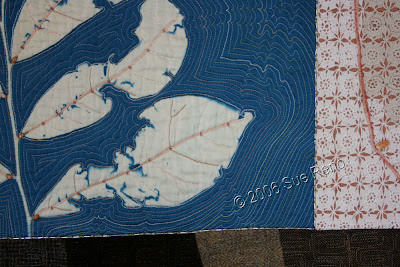 I hurried home and used the leaves for a cyanotype on silk. The sun was so low in the sky I needed to do a very long exposure, over an hour as I recall, as opposed to the 10 minutes or so it takes in high summer. Timing the cyanotypes is as much art as science, with experience as my guide; this time I was pleasantly surprised to see I had got it just right and the print was crisp and intricate, showing all the glorious degradation in the leaves.
I hurried home and used the leaves for a cyanotype on silk. The sun was so low in the sky I needed to do a very long exposure, over an hour as I recall, as opposed to the 10 minutes or so it takes in high summer. Timing the cyanotypes is as much art as science, with experience as my guide; this time I was pleasantly surprised to see I had got it just right and the print was crisp and intricate, showing all the glorious degradation in the leaves.*******************************
The left panel is the "wrong" side of a textured silk tweed fabric. The bottom panel is a mix of Harris tweeds and corduroy, chosen for their texture and the suggestion of tree bark. The top panel is pieced from handpainted silks and silk/hemp fabric, and is beaded with my signature not-too-subtle cloud shapes. The colors suggest the tonal qualities of the weak November sunshine.
******************************
The right panel is really special--it's an overlay of vintage crochet work I found at the flea market at Root's. It started life as a hand-crocheted doily, and what distinguishes it is that there are two different shades of crochet cotton used. I was raised in the Pennsylvania Dutch culture, with a very strong work ethic and thrift ethic, and I can readily imagine what happened here; the maker ran out of the primary thread and used what she had at hand to finish the work. My work on this piece was finished off with some couched yarn and hand application of seed beads, bugle beads, and abalone shell beads.
******************************
"November Pawpaw" has been to several quilt shows, and was included in the PA Arts Experience exhibit at the Lynden Gallery.
October 26, 2009
"Nature Quilts" at Isadore Gallery
 I am very pleased to announce that "Nature Quilts", a solo show of my botanical works, will be at the Isadore Gallery in Lancaster, PA, from November 5 -28. The show will feature a dozen major works from my series "The Woods" and "The Garden", as well as some smaller framed pieces. There will be an opening reception from 5 till 9 pm on November 6th, in conjunction with First Friday activities in Lancaster. I will be there all evening, and I hope that you will be able to attend as well.
I am very pleased to announce that "Nature Quilts", a solo show of my botanical works, will be at the Isadore Gallery in Lancaster, PA, from November 5 -28. The show will feature a dozen major works from my series "The Woods" and "The Garden", as well as some smaller framed pieces. There will be an opening reception from 5 till 9 pm on November 6th, in conjunction with First Friday activities in Lancaster. I will be there all evening, and I hope that you will be able to attend as well.As I was updating the exhibit information on my website, I was struck with how travelled these pieces are--they have been to a wide variety of venues all around the country and even internationally. This is a unique opportunity to see them all hanging side-by-side, in a lovely gallery space in historic downtown Lancaster.
Since the show will consist of twelve pieces, and I have (almost) 12 days until the reception, I would like to spend some time focusing on them individually. Today I am showing "Mystery Fern", which is also on the exhibition postcard. This piece began when I was out rummaging around in the woods and found a patch of ferns I couldn't readily identify. I made some cyanotype and heliographic prints, and adopted Mystery Fern as a working title until such time as I found a positive ID. I never did track it down precisely, but in the process realized that it was OK if it stayed mysterious; there is a lot about the natural world that is beyond facile understanding and classification, and that is part of what draws me back outside again and again.
The green painted panel in the upper left started out as a piece of bridal silk, and has a subtle embroidered pattern on it, and the panel in the lower left is on a silk/hemp blend that has a wonderful rough texture, so the photograph can't quite do justice to its inviting tactile qualities. The fabrics in the patchwork are a blend of a few commercial fabrics and a lot of silks and cottons that I custom painted to get just the right colors and gradations. The small digital prints on cotton are from a photograph I took of the fern fronds while the heliographic prints were drying.
"Mystery Fern" has been exhibited on five different occasions, including "Images 2008", a fine art/fine craft exhibit at Penn State University, where it won the Viewer's Choice award.
October 20, 2009
Watt & Shand #5 and #6 are Underway
 I am on track to having my most productive year ever. I've just finished piecing two tops, numbers 5 and 6 in the Watt & Shand series. They feature screen prints made from a photograph I took early in the construction project, when the historic building had been demolished except for the facade. The facade, which became a part of the new hotel/convention center, was supported by an elaborate, and beautiful in its own right, scaffolding. The solidity of the stone facade and the scaffolding was belied by the cavernous void behind it, and way the blue sky shone through the empty windows. I was transfixed, and decided on the spot to make a series of work documenting the project. (If you are new here, you can track back my work so far by clicking on "Watt & Shand" under Labels in the right sidebar.)
I am on track to having my most productive year ever. I've just finished piecing two tops, numbers 5 and 6 in the Watt & Shand series. They feature screen prints made from a photograph I took early in the construction project, when the historic building had been demolished except for the facade. The facade, which became a part of the new hotel/convention center, was supported by an elaborate, and beautiful in its own right, scaffolding. The solidity of the stone facade and the scaffolding was belied by the cavernous void behind it, and way the blue sky shone through the empty windows. I was transfixed, and decided on the spot to make a series of work documenting the project. (If you are new here, you can track back my work so far by clicking on "Watt & Shand" under Labels in the right sidebar.)  Number 5 and 6 are meant to be companion pieces, although they could easily stand alone. At present they are roughly 36" x 46", medium sized by my standards. I'm quite happy with the way the design work and the piecing went, and look forward to doing the quilting, as the stitching adds so much dimension. And I'm already thinking about #7, so stay tuned!
Number 5 and 6 are meant to be companion pieces, although they could easily stand alone. At present they are roughly 36" x 46", medium sized by my standards. I'm quite happy with the way the design work and the piecing went, and look forward to doing the quilting, as the stitching adds so much dimension. And I'm already thinking about #7, so stay tuned!October 19, 2009
Arts Orientation Center in Lancaster
 A steady stream of visitors and art lovers stopped in at the Arts Orientation Center, the new bricks-and-mortar home of the PA Arts Experience, during Art Walk this past weekend in downtown Lancaster, PA.
A steady stream of visitors and art lovers stopped in at the Arts Orientation Center, the new bricks-and-mortar home of the PA Arts Experience, during Art Walk this past weekend in downtown Lancaster, PA. It's a wonderful setting for member's art, with galleries on the first and second floor of this beautifully restored building on Gallery Row.
It's a wonderful setting for member's art, with galleries on the first and second floor of this beautifully restored building on Gallery Row.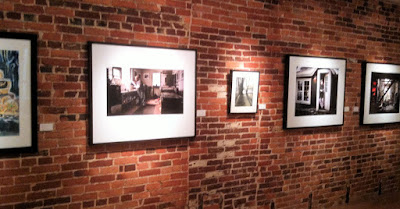 The brick walls discovered during the renovation provide a great backdrop for the art.
The brick walls discovered during the renovation provide a great backdrop for the art. Here's the view of the Center from the 3rd floor of the Prince St. Parking garage across the street, with the lights shining in the window. Come and visit, it's your gateway to discovering the thriving local arts community, including: exhibits of work by regional member trail artists; a Concierge service to design your own itinerary; information about member artists, galleries, museums, and other cultural venues; and arts related tours, packages & educational programs. Regular business hours will commence in November.
Here's the view of the Center from the 3rd floor of the Prince St. Parking garage across the street, with the lights shining in the window. Come and visit, it's your gateway to discovering the thriving local arts community, including: exhibits of work by regional member trail artists; a Concierge service to design your own itinerary; information about member artists, galleries, museums, and other cultural venues; and arts related tours, packages & educational programs. Regular business hours will commence in November.To add to the buzz, the PA Arts Experience was featured in an article in Sunday's Washington Post--read it here.
October 11, 2009
The Pawpaws were thick on the ground
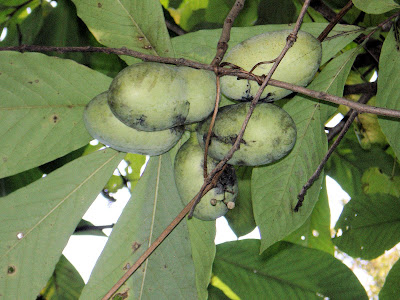 Twenty years ago I found and ate a wild pawpaw fruit while hiking, and ever since then, without being too fanatical about it, I've been looking to repeat the experience, checking various local pawpaw patches in the autumn. Today I hit the jackpot on the Turkey Hill trail, in a spot where the pawpaws were literally thick on the ground, and in the trees.
Twenty years ago I found and ate a wild pawpaw fruit while hiking, and ever since then, without being too fanatical about it, I've been looking to repeat the experience, checking various local pawpaw patches in the autumn. Today I hit the jackpot on the Turkey Hill trail, in a spot where the pawpaws were literally thick on the ground, and in the trees. The timing was perfect, there were plenty that were ripe and ready to cut open and enjoy.
The timing was perfect, there were plenty that were ripe and ready to cut open and enjoy. You scoop out the large seeds and eat the flesh, which should be slightly soft and not tart or bitter. The taste has elements of pineapple, kiwi, and banana, with a hint of honeydew melon. The consistency is even harder to describe; I've seen it called custardy, but it's firmer than custard, yet still melts in the mouth.
You scoop out the large seeds and eat the flesh, which should be slightly soft and not tart or bitter. The taste has elements of pineapple, kiwi, and banana, with a hint of honeydew melon. The consistency is even harder to describe; I've seen it called custardy, but it's firmer than custard, yet still melts in the mouth. I picked a hatful to take home and left the rest for other hikers and the wildlife. Look at the leaves in the above picture--pawpaw leaves are huge and distinctive. I made them the focus of my "November Pawpaw" a few years ago:
I picked a hatful to take home and left the rest for other hikers and the wildlife. Look at the leaves in the above picture--pawpaw leaves are huge and distinctive. I made them the focus of my "November Pawpaw" a few years ago:
We kept hiking to the top of Turkey Hill and enjoyed the views out over the Susquehanna River:
 If you live on the east coast of the U.S. you may be familiar with Turkey Hill dairy products (and convenience stores of the same name). This is the area where the original family dairy farm originated and grew into the modern big enterprise.
If you live on the east coast of the U.S. you may be familiar with Turkey Hill dairy products (and convenience stores of the same name). This is the area where the original family dairy farm originated and grew into the modern big enterprise.
Subscribe to:
Posts (Atom)




